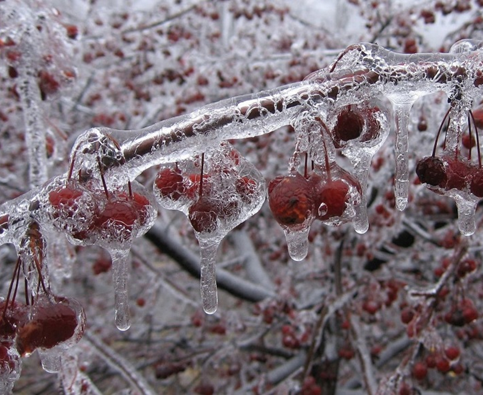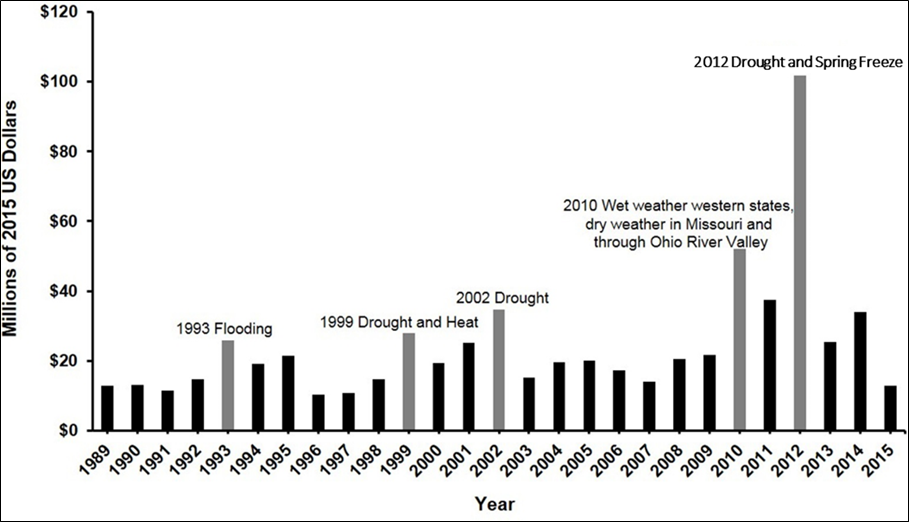Specialty crops crops are more sensitive to climatic stressors and require more intensive management compared to row crops like corn.
Overview
While the Midwest is famous for being the world’s leader in corn and soybean production, this region is also home to a variety of high value specialty crops (Figure. 1 to the right: Percentage of fruit and vegtable cropland across U.S. Image by USDA-FSA). Specialty crops include fruits, vegetables, tree nuts, dried fruits, and nursery crops including floriculture. Because specialty crops have much higher market values compared to traditional row crops, specialty crop production is an important contributor to the Midwest’s rural economy with an estimated annual revenue value of $1.8 billion dollars in 2012. However, these crops are more sensitive to climatic stressors and require more intensive management compared to row crops like corn. As a result, these higher-risk, higher-reward fruits and vegetables have more limited crop insurance coverage than row crops.
A recently published study in Climatic Change by the USDA Midwest Climate Hub shows that shifting weather patterns and future climate change pose a serious threat to specialty crop production in the Midwest.
Temperature Effects
The average Midwest air temperature rose more than 1.5oF from 1900 to 2010. While rising temperatures have resulted in longer growing seasons (increased frost-free periods), crops that break dormancy too early under so-called ‘False Spring’ conditions are at risk for freeze and frost damage. Tree fruits, including apples, cherries, and peaches are especially vulnerable to these spring freeze events. In 2012, Michigan alone lost 90% of their tart cherry crop due to warm March temperatures and subsequent freezes in April (Fig. 2). Projected rising temperatures are also expected to exacerbate the risks posed by some insect pests (European corn borers, corn rootworms) and weeds (Palmer amaranth, giant ragweed) across the region over the next century.

Figure 2. Spring freeze damage to Michigan cherries.
Precipitation Effects
Annual precipitation and heavy precipitation events are increasing, particularly in the spring. Too much spring rainfall disrupts planting, delays crop establishment, increases some fungal and bacterial crop disease incidence, and can lead to labor issues as field work is delayed. In Illinois, heavy rainfall severely reduced 2015’s pumpkin harvest. In the summer, longer dry periods have negatively impacted the production of sweet corn in some years. Long-term future climate projections suggest that longer dry periods in the summer months coupled with rising temperatures will likely reduce both crop quality and quantity.
Weather Induced Crop Losses from 1989 to 2015
Using USDA Risk Management Agency (RMA)’s regional data from 1989 to 2015, trends in Midwestern specialty crop losses due to weather hazards were assessed (Fig. 3). Drought, excessive moisture, and freeze/frost events were the top 3 most frequently reported weather hazards over the last 25 years. Overall, specialty crop indemnity costs (i.e. crop insurance payments) are rising across the Midwest region, with total insurance payments fluctuating between years due to increasingly variable weather patterns as well as shifts in the timing and frequency of extreme weather events. Weather-induced losses also varied by state with excessive moisture being the most commonly reported weather hazard in all Midwestern states except Michigan where spring freeze related insurance claims have risen dramatically.

Figure 3. Annual Midwestern USA indemity costs (crop insurance payments) for specialty crop losses due to weather/ climatic hazards from 1989 to 2015. Image taken from Kistner et al. (2018) in Climatic Change.
Specialty Crop Production Adaptation and Planning Needs
Preliminary surveys indicate that most Midwestern fruit and vegetable growers are well attuned to the increased crop production risks associated with a changing climate. These surveys also revealed the need for additional climate-resilient management practices, decision making/planning tools, and educational resources to help producers better adapt to a variable and changing climate. Examples include:
-
Determining climate-resilient crop rotations or diverse crop plantings that help reduce potentials losses during extreme weather events like drought.
-
Promoting cover crops as a sustainable strategy for maintaining soil integrity under heavy rains and suppressing potential weed infestations.
-
Developing crop-specific weather, production, and financial risk management tools, especially in high tunnel production systems (removable greenhouses) (Fig. 4).
-
Improving insect pest and plant pathogen forecasting and management strategies.

Figure 4. High tunnel covers are becoming increasingly popular with Midwestern vegetable growers. These removable greenhouses naturally extend the growing season while protecting crops from extreme weather events. Photo by USDA-NRCS.
The Take-Away
Overall, increasingly variable weather and climate change will continue to negatively impact Midwestern fruit and vegetable production. However, increased demand for locally grown and organic produce by consumers has resulted in enhanced government agency support for sustainable US specialty crop production under a changing climate. The USDA Midwest Climate Hub hopes to bridge the gap between producers and data to maintain high quality yields and to ensure a healthy local economy. In collaboration with the Midwest Climate Hub, the Midwest Regional Climate Center (MCRR) is currently seeking input from Midwestern fruit and vegetable growers on all weather-related issues and data needs (http://mrcc.isws.illinois.edu/events/SpecialtyCrop/).
By Erica Kistner, Climate Hub Fellow, and Dennis Todey, Director, USDA Midwest Climate Hub
Contact the Midwest Climate Hub to learn more about this content.

